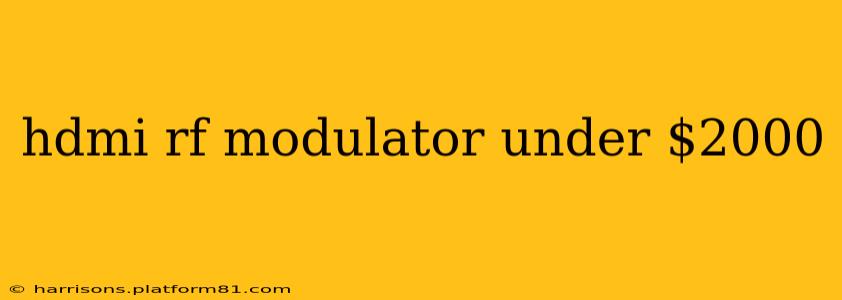High-End HDMI RF Modulators: A Deep Dive into Options Under $2000
Finding the perfect HDMI RF modulator can feel overwhelming, especially when considering the higher-end models. This guide explores the market for premium HDMI RF modulators priced under $2000, focusing on features, applications, and factors to consider when making your selection. While few dedicated, standalone modulators reach this price point, we'll examine systems that incorporate advanced modulation capabilities, focusing on professional-grade options and their suitability for specific needs.
What is an HDMI RF Modulator?
Before delving into specific products, let's clarify what an HDMI RF modulator does. It takes an HDMI signal (carrying video and audio from sources like Blu-ray players, game consoles, or computers) and converts it into a radio frequency (RF) signal suitable for transmission over coaxial cables. This allows you to distribute the HDMI source to multiple televisions or displays using a standard cable TV infrastructure.
Why Spend Over $1000 on an HDMI RF Modulator?
The price point of over $1000 for an HDMI RF modulator often implies features exceeding those found in consumer-grade models. These advanced capabilities might include:
- Superior Signal Quality: High-end modulators prioritize minimal signal loss and superior picture clarity, vital for professional broadcasting or large-scale deployments.
- Multiple Input/Output Channels: These systems can handle numerous HDMI sources and output channels simultaneously, crucial for large venues or multi-room distribution.
- Advanced Modulation Schemes: They often support advanced modulation techniques that improve bandwidth efficiency and signal resilience.
- Remote Monitoring and Control: Professional-grade systems often offer remote monitoring and control capabilities, simplifying management and troubleshooting.
- Robust Construction and Reliability: Expect superior build quality, designed for continuous operation in demanding environments.
Where to Find High-End Modulation Capabilities (Under $2000):
It's crucial to note that dedicated HDMI RF modulators rarely hit the $1000-$2000 price bracket. Instead, this price range typically falls into systems designed for professional broadcasting, video conferencing, or security applications. These systems often integrate multiple features, with RF modulation being one component. You might find suitable solutions by searching for:
- Professional-grade encoders and transmitters: These systems offer high-quality signal encoding and RF transmission, frequently including multiple HDMI inputs and RF outputs. Look for specifications related to bandwidth, modulation type (e.g., COFDM, DVB-T2), and power output.
- Head-end systems for commercial installations: These systems are designed for distributing signals across larger areas, offering advanced features like multi-channel encoding, remote management, and redundancy for reliable signal delivery.
- Video over IP solutions: Some advanced IP-based video distribution systems include RF modulation as part of their functionality. They often offer flexible deployment options and superior signal management.
Factors to Consider When Choosing a System:
- Number of Inputs and Outputs: Determine the number of HDMI sources and displays you need to support.
- Modulation Scheme: Consider the type of RF modulation used (e.g., QAM, COFDM) as this affects signal quality and transmission range.
- Bandwidth and Channel Capacity: Ensure the system supports the resolution and bandwidth required for your video sources.
- Distance of Transmission: Longer transmission distances may require higher power output and potentially repeaters.
- Remote Management Capabilities: Consider the importance of remote monitoring and control, crucial for large installations.
- Scalability: Choose a system that can accommodate future expansion.
Frequently Asked Questions (FAQs)
What kind of coaxial cable is best for distributing RF signals from a modulator?
The best coaxial cable depends on the distance and frequency range involved. High-quality coaxial cables with low signal loss are essential for preserving picture quality over longer distances. RG-6 is a common choice for many applications.
Can I use a standard HDMI splitter to distribute the signal before modulation?
While possible, it's generally not recommended. Using a splitter before the modulator might compromise signal quality, especially over longer distances. It's more efficient to have multiple inputs on your encoder/transmitter.
What about wireless RF modulation?
Wireless RF modulation is feasible using dedicated transmitters and receivers, but this often adds complexity and potentially reduces signal reliability, especially compared to wired coaxial cable solutions.
Is it necessary to have a license to operate an HDMI RF modulator?
Licensing requirements for RF modulation depend on the frequency band used and local regulations. Some frequencies may require licenses for broadcasting or commercial applications.
What about troubleshooting issues with RF signal strength?
Troubleshooting weak signals often involves checking cable quality and connections, verifying the modulator's settings, and measuring the signal strength at the receiver end.
This guide provides a starting point for exploring high-end HDMI RF modulation solutions under $2000. Remember to consult with professionals experienced in RF systems and signal distribution for projects requiring robust, high-quality solutions. Always check local regulations regarding RF transmissions before implementing any system.
